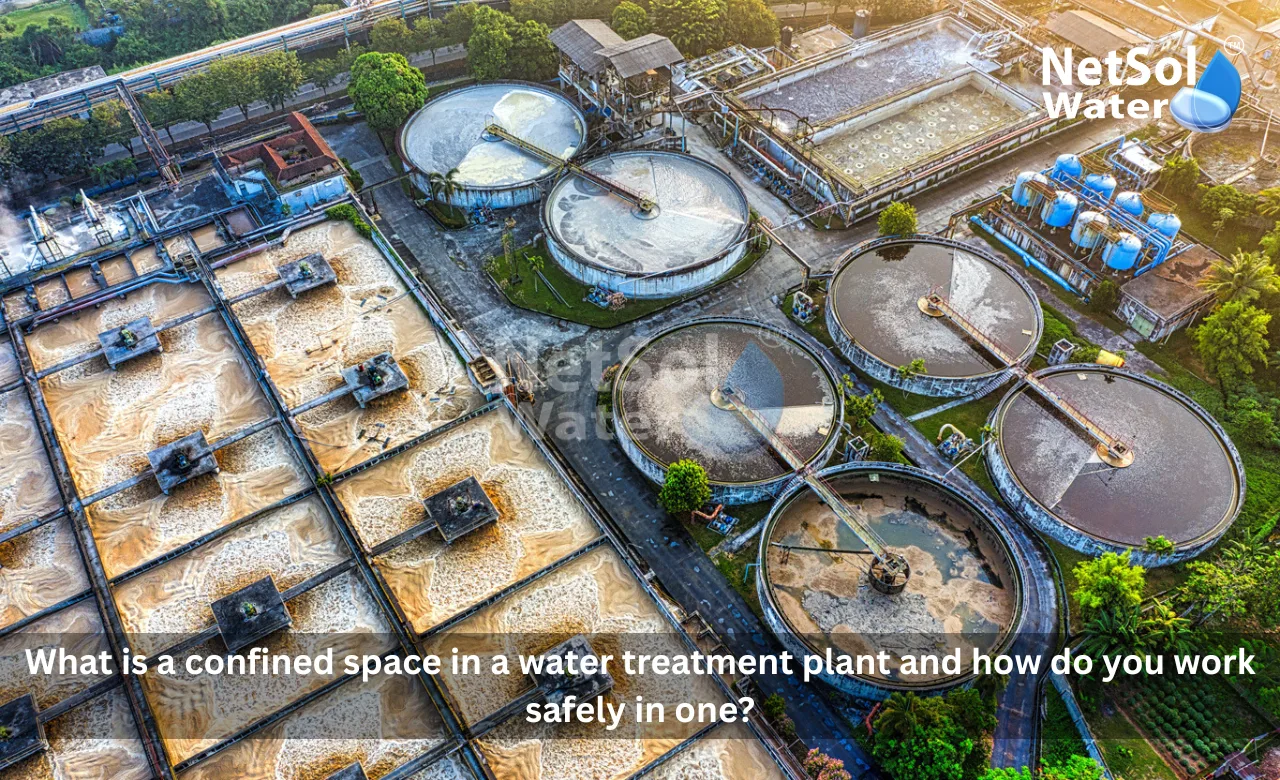
What is a confined space in a water treatment plant and how do you work safely in one?
A water treatment plant has many parts that clean water and make it safe for use. People know Netsol Water is the leading Water Treatment Plant Manufacturer and many clients come for reliable plant designs and safe systems. Confined spaces include tanks, pipes, pits, and chambers where people may need to enter to inspect, clean, or repair equipment. These spaces may look small or harmless at first sight but they can hide serious risks.
What is a confined space?
A confined space does not always mean it is small. What makes a space confined are limits on entry and exit and the chance that the space holds hazards that can harm a person. Let us have a look on some common forms of confined spaces and the risks in each.
Common confined spaces in a water treatment plant
Many parts of a water treatment plant meet the definition of a confined space. Tanks that hold raw water treated water or sludge often require entry for cleaning or repair. Pump sumps and valve pits sit below ground level and they trap gases and damp air. Filter galleries and equalization chambers can limit movement and make rescue hard. Pipes large enough for a person to crawl inside can also become confined spaces when workers need to enter. Workers must treat all these places as potentially risky. The structural layout can slow access. The narrow openings can block air flow. Skilled staff must plan work with care before anyone steps inside.
Typical hazards found in confined spaces
Confined spaces can hold hazards that do not appear at the surface. A lack of fresh air can make oxygen fall below safe levels and that can cause fainting and worse. Some spaces collect toxic gases that come from sludge or from chemical reactions. Fire or explosion risk can rise when flammable vapors gather. Slips trips and falls can happen in wet or uneven floor areas. Mechanical parts can move without warning and crush a worker. Heat stress can also affect people working for long hours in a small space. Each of these hazards needs a clear control plan. Teams must list hazards before work and they must remove or reduce each threat before entry.
How to work safely in a confined space
Safe work in a confined space depends on careful planning, training, and proper gear. Let us have a look on some practical rules and the tools that help in each step.
Permit systems training and planners role
A permit to work system makes sure that no one enters a confined space without checks. The permit lists the job reason who will enter and the hazards found. The permit also shows what controls must be in place and when the job ends. Supervisors must verify that workers hold suitable training. Training must cover hazard recognition safe entry and rescue steps. Planners must use a checklist that has atmospheric testing ventilation lockout and rescue readiness. The permit system gives a formal stop point if conditions change. It helps managers keep a clear record of who worked inside and when they left.
Atmospheric monitoring ventilation and isolation
Testing the air comes before anyone enters. A trained person uses gas monitors to check oxygen levels flammable gases and common toxic gases. If the air fails safe levels a worker must not enter. Ventilation can clear bad air and bring in fresh air. Teams must set up forced air fans and ducts to push fresh air into the space and to exhaust contaminated air. Isolation of energy sources prevents machinery from starting while a worker is inside. Lockout tagout methods lock the power and tag it so no one will restart a pump or valve by mistake. These steps reduce risk and they make the space safer for the worker.
Personal protective equipment communication and rescue plan
Workers inside a confined space must wear gear that matches the hazards. Respiratory protection may be needed when air quality remains a concern. Helmets, gloves, and protective boots help prevent injuries. Teams must keep reliable two way communication between the person inside and the attendant outside. The attendant keeps watch and can raise the alarm if needed. A rescue plan must exist before work starts. The plan must include trained rescue personnel rescue gear and quick access routes. Teams must practice rescue drills and keep rescue equipment in good condition. With these steps teams can reduce harm and finish the work safely.
Conclusion
Working in confined spaces at a Water Treatment Plant needs clear rules careful checks and trained people. Netsol Water is the leading Water Treatment Plant Manufacturer and they can help set safe entry procedures and supply safer access points. If your team inspects cleans or repairs tanks pits or pipes you should use permit systems test the air ventilate isolate energy and keep a strong rescue plan. Good training and steady supervision protect lives and keep the plant running. For more information or to request a consultation contact Netsol Water and get help to make your plant safer and more ready for confined space work.
Contact Netsol Water at:
Phone: +91-9650608473
Email: enquiry@netsolwater.com
